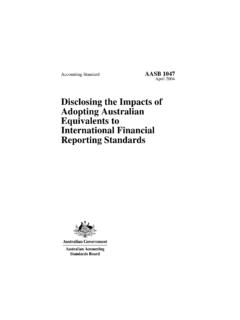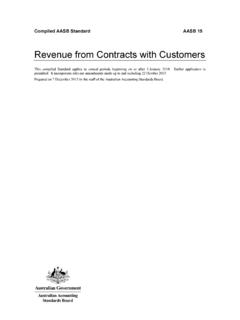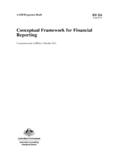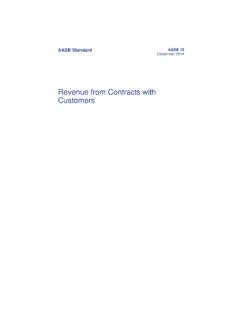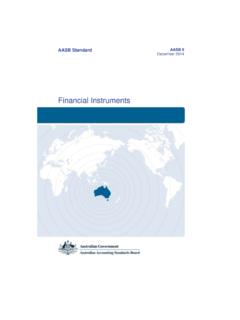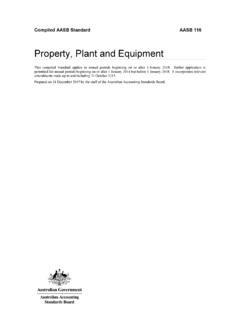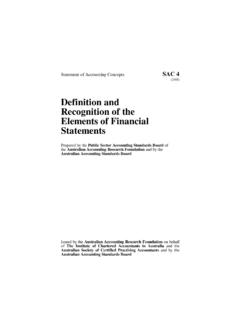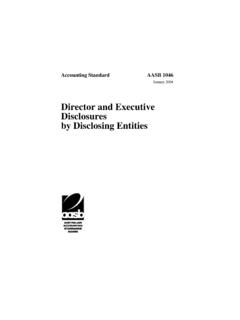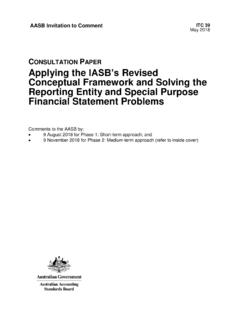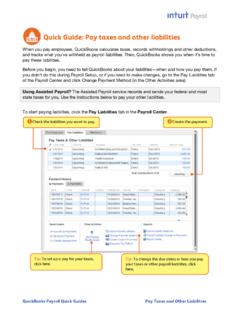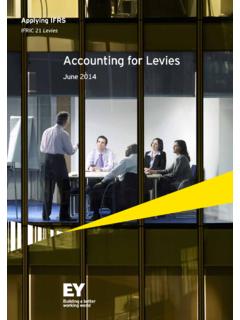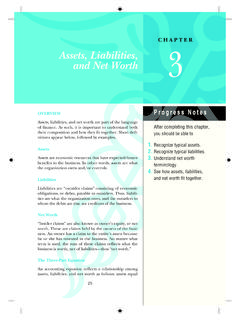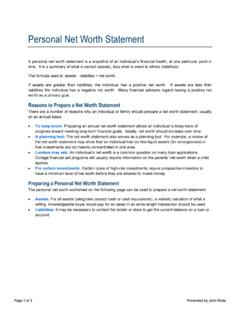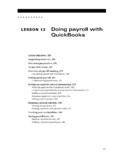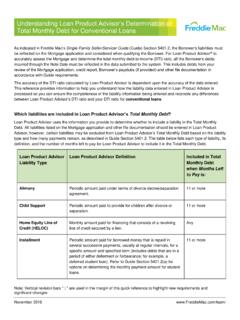Transcription of Provisions, Contingent Liabilities and Contingent …
1 AASB Standard AASB 137. August 2015. Provisions, Contingent Liabilities and Contingent Assets Federal Register of Legislative Instruments F2015L01607. Obtaining a copy of this Accounting Standard This Standard is available on the AASB website: Australian Accounting Standards Board PO Box 204. Collins Street West Victoria 8007. AUSTRALIA. Phone: (03) 9617 7637. E-mail: Website: Other enquiries Phone: (03) 9617 7600. E-mail: COPYRIGHT. Commonwealth of Australia 2015. This AASB Standard contains IFRS Foundation copyright material. Reproduction within Australia in unaltered form (retaining this notice) is permitted for personal and non-commercial use subject to the inclusion of an acknowledgment of the source. Requests and enquiries concerning reproduction and rights for commercial purposes within Australia should be addressed to The Director of Finance and Administration, Australian Accounting Standards Board, PO Box 204, Collins Street West, Victoria 8007. All existing rights in this material are reserved outside Australia.
2 Reproduction outside Australia in unaltered form (retaining this notice) is permitted for personal and non-commercial use only. Further information and requests for authorisation to reproduce for commercial purposes outside Australia should be addressed to the IFRS Foundation at ISSN 1036-4803. AASB 137 2 COPYRIGHT. Federal Register of Legislative Instruments F2015L01607. Contents COMPARISON WITH IAS 37. ACCOUNTING STANDARD. AASB 137 PROVISIONS, Contingent Liabilities AND Contingent ASSETS. from paragraph OBJECTIVE. SCOPE 1. DEFINITIONS 10. Provisions and other Liabilities 11. Relationship between provisions and Contingent Liabilities 12. RECOGNITION. Provisions 14. Present obligation 15. Past event 17. Probable outflow of resources embodying economic benefits 23. Reliable estimate of the obligation 25. Recognition of Liabilities arising from local government and government existing public policies, budget policies, election promises or statements of intent Contingent Liabilities 27.
3 Contingent assets 31. MEASUREMENT. Best estimate 36. Risks and uncertainties 42. Present value 45. Future events 48. Expected disposal of assets 51. REIMBURSEMENTS 53. CHANGES IN PROVISIONS 59. USE OF PROVISIONS 61. APPLICATION OF THE RECOGNITION AND MEASUREMENT RULES. Future operating losses 63. Onerous contracts 66. Restructuring 70. DISCLOSURE 84. TRANSITIONAL PROVISIONS 93. COMMENCEMENT OF THE LEGISLATIVE INSTRUMENT WITHDRAWAL OF AASB PRONOUNCEMENTS EFFECTIVE DATE 95. APPENDIX. A Australian reduced disclosure requirements IMPLEMENTATION GUIDANCE. A Tables Provisions, Contingent Liabilities , Contingent assets and reimbursements B Decision tree C Examples: recognition D Examples: disclosures DELETED IAS 37 TEXT. AASB 137 3 CONTENTS. Federal Register of Legislative Instruments F2015L01607. Australian Accounting Standard AASB 137 Provisions, Contingent Liabilities and Contingent Assets is set out in paragraphs 1 101 and Appendix A. All the paragraphs have equal authority.
4 Paragraphs in bold type state the main principles. AASB 137 is to be read in the context of other Australian Accounting Standards, including AASB 1048. Interpretation of Standards, which identifies the Australian Accounting Interpretations, and AASB 1057 Application of Australian Accounting Standards. In the absence of explicit guidance, AASB 108 Accounting Policies, Changes in Accounting Estimates and Errors provides a basis for selecting and applying accounting policies. AASB 137 4 CONTENTS. Federal Register of Legislative Instruments F2015L01607. Comparison with IAS 37. AASB 137 Provisions, Contingent Liabilities and Contingent Assets incorporates IAS 37 Provisions, Contingent Liabilities and Contingent Assets issued by the International Accounting Standards Board (IASB). Australian-specific paragraphs (which are not included in IAS 37) are identified with the prefix Aus . Paragraphs that apply only to not- for-profit entities begin by identifying their limited applicability.
5 Tier 1. For-profit entities complying with AASB 137 also comply with IAS 37. Not-for-profit entities' compliance with IAS 37 will depend on whether any Aus paragraphs that specifically apply to not-for-profit entities provide additional guidance or contain applicable requirements that are inconsistent with IAS 37. Tier 2. Entities preparing general purpose financial statements under Australian Accounting Standards Reduced Disclosure Requirements (Tier 2) will not be in compliance with IFRSs. AASB 1053 Application of Tiers of Australian Accounting Standards explains the two tiers of reporting requirements. AASB 137 5 COMPARISON. Federal Register of Legislative Instruments F2015L01607. Accounting Standard AASB 137. The Australian Accounting Standards Board makes Accounting Standard AASB 137 Provisions, Contingent Liabilities and Contingent Assets under section 334 of the Corporations Act 2001. Kris Peach Dated 14 August 2015 Chair AASB. Accounting Standard AASB 137.
6 Provisions, Contingent Liabilities and Contingent Assets Objective The objective of this Standard is to ensure that appropriate recognition criteria and measurement bases are applied to provisions, Contingent Liabilities and Contingent assets and that sufficient information is disclosed in the notes to enable users to understand their nature, timing and amount. Scope 1 This Standard shall be applied by all entities in accounting for provisions, Contingent Liabilities and Contingent assets, except: (a) those resulting from executory contracts, except where the contract is onerous; and (b) [deleted]. (c) those covered by another Standard. 2 This Standard does not apply to financial instruments (including guarantees) that are within the scope of AASB 9 Financial Instruments. 3 Executory contracts are contracts under which neither party has performed any of its obligations or both parties have partially performed their obligations to an equal extent. This Standard does not apply to executory contracts unless they are onerous.
7 4 [Deleted]. 5 When another Standard deals with a specific type of provision, Contingent liability or Contingent asset, an entity applies that Standard instead of this Standard. For example, some types of provisions are addressed in Standards on: (a) [deleted]. (b) income taxes (see AASB 112 Income Taxes);. (c) leases (see AASB 117 Leases). However, as AASB 117 contains no specific requirements to deal with operating leases that have become onerous, this Standard applies to such cases;. (d) employee benefits (see AASB 119 Employee Benefits);. (e) insurance contracts (see AASB 4 Insurance Contracts, AASB 1023 General Insurance Contracts, and AASB 1038 Life Insurance Contracts). However, this Standard applies to provisions, Contingent Liabilities and Contingent assets of an insurer, other than those arising from its contractual obligations and rights under insurance contracts within the scopes of AASB 4, AASB 1023 or AASB 1038;. (f) Contingent consideration of an acquirer in a business combination (see AASB 3 Business Combinations); and (g) revenue from contracts with customers (see AASB 15 Revenue from Contracts with Customers).
8 However, as AASB 15 contains no specific requirements to address contracts with customers that are, or have become, onerous, this Standard applies to such cases. 6 [Deleted]. AASB 137 6 STANDARD. Federal Register of Legislative Instruments F2015L01607. 7 This Standard defines provisions as Liabilities of uncertain timing or amount. In some countries the term provision' is also used in the context of items such as depreciation, impairment of assets and doubtful debts: these are adjustments to the carrying amounts of assets and are not addressed in this Standard. 8 Other Standards specify whether expenditures are treated as assets or as expenses. These issues are not addressed in this Standard. Accordingly, this Standard neither prohibits nor requires capitalisation of the costs recognised when a provision is made. 9 This Standard applies to provisions for restructurings (including discontinued operations). When a restructuring meets the definition of a discontinued operation, additional disclosures may be required by AASB 5 Non-current Assets Held for Sale and Discontinued Operations.
9 Definitions 10 The following terms are used in this Standard with the meanings specified: A provision is a liability of uncertain timing or amount. A liability is a present obligation of the entity arising from past events, the settlement of which is expected to result in an outflow from the entity of resources embodying economic benefits. An obligating event is an event that creates a legal or constructive obligation that results in an entity having no realistic alternative to settling that obligation. A legal obligation is an obligation that derives from: (a) a contract (through its explicit or implicit terms);. (b) legislation; or (c) other operation of law. A constructive obligation is an obligation that derives from an entity's actions where: (a) by an established pattern of past practice, published policies or a sufficiently specific current statement, the entity has indicated to other parties that it will accept certain responsibilities; and (b) as a result, the entity has created a valid expectation on the part of those other parties that it will discharge those responsibilities.
10 A Contingent liability is: (a) a possible obligation that arises from past events and whose existence will be confirmed only by the occurrence or non-occurrence of one or more uncertain future events not wholly within the control of the entity; or (b) a present obligation that arises from past events but is not recognised because: (i) it is not probable that an outflow of resources embodying economic benefits will be required to settle the obligation; or (ii) the amount of the obligation cannot be measured with sufficient reliability. A Contingent asset is a possible asset that arises from past events and whose existence will be confirmed only by the occurrence or non-occurrence of one or more uncertain future events not wholly within the control of the entity. An onerous contract is a contract in which the unavoidable costs of meeting the obligations under the contract exceed the economic benefits expected to be received under it. A restructuring is a programme that is planned and controlled by management, and materially changes either: (a) the scope of a business undertaken by an entity; or (b) the manner in which that business is conducted.
